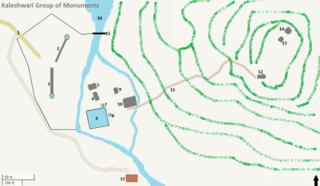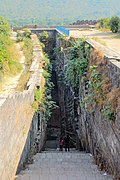
Junagadh is the city and headquarters of Junagadh district in the Indian state of Gujarat. Located at the foot of the Girnar hills, 355 kilometres (221 mi) southwest of Ahmedabad and Gandhinagar, it is the seventh largest city in the state. It is dominated by the Chudasama clan of Rajputs since ancient times.

Stepwells are wells, cisterns or ponds with a long corridor of steps that descend to the water level. Stepwells played a significant role in defining subterranean architecture in western India from the 7th to the 19th century. Some stepwells are multi-storeyed and can be accessed by a Persian wheel which is pulled by a bull to bring water to the first or second floor. They are most common in western India and are also found in the other more arid regions of the Indian subcontinent, extending into Pakistan. The construction of stepwells is mainly utilitarian, though they may include embellishments of architectural significance, and be temple tanks.

Agrasen Ki Baoli is a 60-meter long and 15-meter wide historical stepwell in New Delhi, India.

Rani Ki Vav is a stepwell situated in the town of Patan in Gujarat, India. It is located on the banks of the Saraswati River. Its construction is attributed to Udayamati, the spouse of the 11th-century Chaulukya king Bhima I. Silted over, it was rediscovered in the 1940s and restored in the 1980s by the Archaeological Survey of India. It has been listed as one of the UNESCO World Heritage Sites in India since 2014. The stepwell is designed as an underground shrine or inverted temple; representing the sanctity of water, with the sculptures in the stepwell depicting numerous Hindu deities.

Chand Baori is a stepwell situated in the village of Abhaneri in the Indian state of Rajasthan. It extends approximately 30 m (100 ft) into the ground, making it one of the deepest and largest stepwells in India. It is named after a local ruler of Nikumbh dynasty called Raja Chanda and its construction is dated to the 8th-9th century. It has 3500 steps cascading 13 stories deep into a massive tank at the bottom and has been constructed in an upside-down pyramid-style.

Adalaj Stepwell or Rudabai Stepwell is a stepwell located in the small town of Adalaj, close to Gandhinagar city in the Indian state of Gujarat. It was built in 1498 in the memory of Rana Veer Singh of the Vaghela dynasty.

Navaghana was an early Chudasama king known only from the ballads and folklore of Saurashtra of Gujarat, India. His capital was at Vamanasthali which he later moved to Junagadh during his last years of reign.

Junagadh Cave Groups are located in Junagadh district of the Indian state of Gujarat. These caves group includes Uparkot Caves, Khapra Kodiya Caves and Baba Pyare Caves. Three separate sites of rooms carved out of stone to be used as monks' quarters. These caves were carved starting from Emperor Ashoka's period up to 1st–4th century AD.

Bai Harir Sultani Stepwell is a 15th century stepwell in Asarwa area 15 km off Ahmedabad, Gujarat, India.

Mata Bhavani's Stepwell or Mata Bhavani ni Vav is a stepwell in Asarwa area of Ahmedabad, Gujarat, India.
The Chudasama dynasty, a Samma branch, ruled parts of the present-day Saurashtra region of Gujarat state in India between the 9th and 15th centuries. Their capital was based in Junagadh and Vamanasthali.
Stepwells are wells in which the water is reached by steps. They are most commonly found in western India especially Gujarat where over 120 such wells are reported. The origin of the stepwell may be traced to reservoirs of the cities of the Indus Valley civilization such as Dholavira and Mohenjo-daro. The stepwells were constructed in the south western region of Gujarat around 600 AD. From there they spread north to Rajasthan and subsequently to north and west India. Construction activities accelerated during the tenth to 13th century during the Chaulukya and Vaghela periods. The construction of these stepwells hit its peak during the 11th to 16th century. The Muslim rulers of the 13th to 16th century did not disrupt the culture that was practiced in these stepwells and encouraged the building of stepwells. The wells lost their significance in the 19th century due to introduction of water pumps and pipe-systems.

Uparkot caves, also Uperkot caves, are ancient man-made caverns. The caves are a part of the Junagadh Buddhist Cave Groups situated in the eastern part of Junagadh of the Indian state of Gujarat.

The Kaleshwari Group of Monuments, also known as Kaleshwari-Ni Nal, is located near Lavana village, Khanpur Taluka of Mahisagar district, Gujarat, India. It is near the district headquarters Lunavada and near a stream in Hidimba Van, the forest of Hidimba. The group includes intricately-carved temple ruins, two stepwells, a reservoir, structures with panels of erotic sculptures and idols scattered all over the site. The ruins are located at the foothills and on the hillock. They were built between the 10th and 16th century; some monuments were reconstructed after the 18th century. These are State Protected Monuments. It's believed that the site was selected for constructing the complex since it was situated on the old trade route from Gujarat to Rajasthan
Madhavav or Madhav Vav is a stepwell located in Wadhwan town of Surendranagar district, Gujarat, India. It is located in the western side of old town.

Uparkot is a fort located in east side of Junagadh, Gujarat, India.

Navghan Kuvo is a stepwell in Uparkot Fort, Junagadh, Gujarat, India.
Ra Khengar Vav or Ra Khengar stepwell is a 13th-century stepwell located near Koyliphatak village between Vanthali and Junagadh in Gujarat, India.
Matri Vav is a stepwell in Kankavati village of Dhrangadhra Taluka of Surendranagar district, Gujarat, India. It was approximately built in early 17th century. The stepped corridor of the stepwell has five pavilion-towers and four intermediate frames. It has decorated niches and well shaft.
Modhera Vav is a stepwell in Modhera village in Mehsana district, Gujarat, India. The stepwell belongs to the 11th century while the mandapa origins from the 10th century. It is the state protected monument.
















